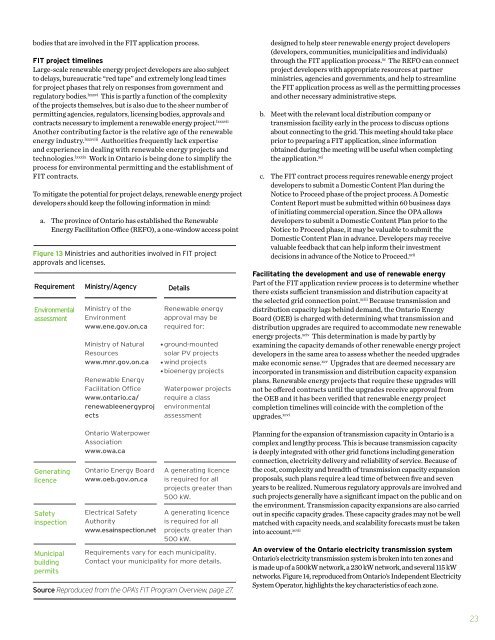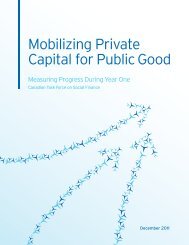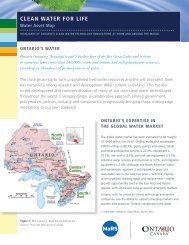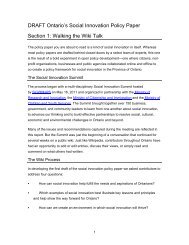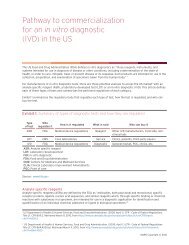Feed-in tariffs Accelerating renewable energy project development ...
Feed-in tariffs Accelerating renewable energy project development ...
Feed-in tariffs Accelerating renewable energy project development ...
You also want an ePaper? Increase the reach of your titles
YUMPU automatically turns print PDFs into web optimized ePapers that Google loves.
odies that are <strong>in</strong>volved <strong>in</strong> the FIT application process.<br />
FIT <strong>project</strong> timel<strong>in</strong>es<br />
Large-scale <strong>renewable</strong> <strong>energy</strong> <strong>project</strong> developers are also subject<br />
to delays, bureaucratic “red tape” and extremely long lead times<br />
for <strong>project</strong> phases that rely on responses from government and<br />
regulatory bodies. lxxxvi This is partly a function of the complexity<br />
of the <strong>project</strong>s themselves, but is also due to the sheer number of<br />
permitt<strong>in</strong>g agencies, regulators, licens<strong>in</strong>g bodies, approvals and<br />
contracts necessary to implement a <strong>renewable</strong> <strong>energy</strong> <strong>project</strong>. lxxxvii<br />
Another contribut<strong>in</strong>g factor is the relative age of the <strong>renewable</strong><br />
<strong>energy</strong> <strong>in</strong>dustry. lxxxviii Authorities frequently lack expertise<br />
and experience <strong>in</strong> deal<strong>in</strong>g with <strong>renewable</strong> <strong>energy</strong> <strong>project</strong>s and<br />
technologies. lxxxix Work <strong>in</strong> Ontario is be<strong>in</strong>g done to simplify the<br />
process for environmental permitt<strong>in</strong>g and the establishment of<br />
FIT contracts.<br />
To mitigate the potential for <strong>project</strong> delays, <strong>renewable</strong> <strong>energy</strong> <strong>project</strong><br />
developers should keep the follow<strong>in</strong>g <strong>in</strong>formation <strong>in</strong> m<strong>in</strong>d:<br />
a. The prov<strong>in</strong>ce of Ontario has established the Renewable<br />
Energy Facilitation Office (REFO), a one-w<strong>in</strong>dow access po<strong>in</strong>t<br />
Figure 13 M<strong>in</strong>istries and authorities <strong>in</strong>volved <strong>in</strong> FIT <strong>project</strong><br />
approvals and licenses.<br />
Requirement<br />
Environmental<br />
assessment<br />
Generat<strong>in</strong>g<br />
licence<br />
Safety<br />
<strong>in</strong>spection<br />
Municipal<br />
build<strong>in</strong>g<br />
permits<br />
M<strong>in</strong>istry/Agency<br />
M<strong>in</strong>istry of the<br />
Environment<br />
www.ene.gov.on.ca<br />
M<strong>in</strong>istry of Natural<br />
Resources<br />
www.mnr.gov.on.ca<br />
Renewable Energy<br />
Facilitation Office<br />
www.ontario.ca/<br />
<strong>renewable</strong><strong>energy</strong>proj<br />
ects<br />
Ontario Waterpower<br />
Association<br />
www.owa.ca<br />
Ontario Energy Board<br />
www.oeb.gov.on.ca<br />
Electrical Safety<br />
Authority<br />
www.esa<strong>in</strong>spection.net<br />
Details<br />
Renewable <strong>energy</strong><br />
approval may be<br />
required for:<br />
ground-mounted<br />
solar PV <strong>project</strong>s<br />
w<strong>in</strong>d <strong>project</strong>s<br />
bio<strong>energy</strong> <strong>project</strong>s<br />
Waterpower <strong>project</strong>s<br />
require a class<br />
environmental<br />
assessment<br />
A generat<strong>in</strong>g licence<br />
is required for all<br />
<strong>project</strong>s greater than<br />
500 kW.<br />
A generat<strong>in</strong>g licence<br />
is required for all<br />
<strong>project</strong>s greater than<br />
500 kW.<br />
Requirements vary for each municipality.<br />
Contact your municipality for more details.<br />
Source Reproduced from the OPA’s FIT Program Overview, page 27.<br />
designed to help steer <strong>renewable</strong> <strong>energy</strong> <strong>project</strong> developers<br />
(developers, communities, municipalities and <strong>in</strong>dividuals)<br />
through the FIT application process. xc The REFO can connect<br />
<strong>project</strong> developers with appropriate resources at partner<br />
m<strong>in</strong>istries, agencies and governments, and help to streaml<strong>in</strong>e<br />
the FIT application process as well as the permitt<strong>in</strong>g processes<br />
and other necessary adm<strong>in</strong>istrative steps.<br />
b. Meet with the relevant local distribution company or<br />
transmission facility early <strong>in</strong> the process to discuss options<br />
about connect<strong>in</strong>g to the grid. This meet<strong>in</strong>g should take place<br />
prior to prepar<strong>in</strong>g a FIT application, s<strong>in</strong>ce <strong>in</strong>formation<br />
obta<strong>in</strong>ed dur<strong>in</strong>g the meet<strong>in</strong>g will be useful when complet<strong>in</strong>g<br />
the application. xci<br />
c. The FIT contract process requires <strong>renewable</strong> <strong>energy</strong> <strong>project</strong><br />
developers to submit a Domestic Content Plan dur<strong>in</strong>g the<br />
Notice to Proceed phase of the <strong>project</strong> process. A Domestic<br />
Content Report must be submitted with<strong>in</strong> 60 bus<strong>in</strong>ess days<br />
of <strong>in</strong>itiat<strong>in</strong>g commercial operation. S<strong>in</strong>ce the OPA allows<br />
developers to submit a Domestic Content Plan prior to the<br />
Notice to Proceed phase, it may be valuable to submit the<br />
Domestic Content Plan <strong>in</strong> advance. Developers may receive<br />
valuable feedback that can help <strong>in</strong>form their <strong>in</strong>vestment<br />
decisions <strong>in</strong> advance of the Notice to Proceed. xcii<br />
Facilitat<strong>in</strong>g the <strong>development</strong> and use of <strong>renewable</strong> <strong>energy</strong><br />
Part of the FIT application review process is to determ<strong>in</strong>e whether<br />
there exists sufficient transmission and distribution capacity at<br />
the selected grid connection po<strong>in</strong>t. xciii Because transmission and<br />
distribution capacity lags beh<strong>in</strong>d demand, the Ontario Energy<br />
Board (OEB) is charged with determ<strong>in</strong><strong>in</strong>g what transmission and<br />
distribution upgrades are required to accommodate new <strong>renewable</strong><br />
<strong>energy</strong> <strong>project</strong>s. xciv This determ<strong>in</strong>ation is made by partly by<br />
exam<strong>in</strong><strong>in</strong>g the capacity demands of other <strong>renewable</strong> <strong>energy</strong> <strong>project</strong><br />
developers <strong>in</strong> the same area to assess whether the needed upgrades<br />
make economic sense. xcv Upgrades that are deemed necessary are<br />
<strong>in</strong>corporated <strong>in</strong> transmission and distribution capacity expansion<br />
plans. Renewable <strong>energy</strong> <strong>project</strong>s that require these upgrades will<br />
not be offered contracts until the upgrades receive approval from<br />
the OEB and it has been verified that <strong>renewable</strong> <strong>energy</strong> <strong>project</strong><br />
completion timel<strong>in</strong>es will co<strong>in</strong>cide with the completion of the<br />
upgrades. xcvi<br />
Plann<strong>in</strong>g for the expansion of transmission capacity <strong>in</strong> Ontario is a<br />
complex and lengthy process. This is because transmission capacity<br />
is deeply <strong>in</strong>tegrated with other grid functions <strong>in</strong>clud<strong>in</strong>g generation<br />
connection, electricity delivery and reliability of service. Because of<br />
the cost, complexity and breadth of transmission capacity expansion<br />
proposals, such plans require a lead time of between five and seven<br />
years to be realized. Numerous regulatory approvals are <strong>in</strong>volved and<br />
such <strong>project</strong>s generally have a significant impact on the public and on<br />
the environment. Transmission capacity expansions are also carried<br />
out <strong>in</strong> specific capacity grades. These capacity grades may not be well<br />
matched with capacity needs, and scalability forecasts must be taken<br />
<strong>in</strong>to account. xcvii<br />
An overview of the Ontario electricity transmission system<br />
Ontario’s electricity transmission system is broken <strong>in</strong>to ten zones and<br />
is made up of a 500kW network, a 230 kW network, and several 115 kW<br />
networks. Figure 14, reproduced from Ontario’s Independent Electricity<br />
System Operator, highlights the key characteristics of each zone.<br />
23


